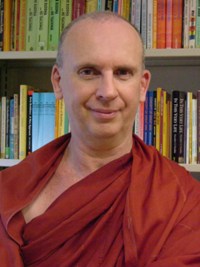 The Body
The BodyThe body (kaya) is the physical structure of the individual. According to the Buddha’s analysis, the body is one of the five constituents that make up the individual together with feelings, perception, mental constructs and consciousness, and consists of the elements of solidity, fluidity, caloricity and space (D.II,294). He describes the body as “material, made of the four elements, derived from mother and father, maintained on rice and gruel, impermanent, liable to injury and abrasion, being broken and destroyed, bound up with consciousness and dependent on it” (D.I,76). Following the medical theories of the time, he identified 31 significant body-parts - hair of the head, body hair, nails, teeth, skin, muscle tissue, ligaments, bones, marrow, kidneys, heart, liver, diaphragm, spleen, lungs, intestines, bowels, stomach, faeces, bile, phlegm, pus, blood, sweat, fat, tears, body oil, saliva, nasal mucus, lymphatic fluid and urine (M.I,57). Later commentators added a 32nd part, the brain. The body was also said to nine orifices (nava sota); the two eyes, ears and nostrils, the mouth, anus and urethra (Sn.197)
The Buddha said that physical attractiveness is a blessing (A.III,47) and who could argue with him. First impressions are important and being good-looking always creates a favourable impression. The Buddha saw a relationship between physical beauty and goodness, saying that one of the vipakas of virtue is good-looks (M.III,204). I must say, I have serious doubts about this but there it is! The five types of human beauty are beautiful complexion, beautiful hair, beautiful muscle structure, beautiful teeth and the beauty of youth (Ja.I,394). In the Buddha’s world a complexion which was “not too dark and not too fair” was considered the most desirable (M.I,88).
The Buddha recommended sometimes contemplating the unpleasant aspects of the body. This was not because he believed that the body is disgusting, but to balance the general tendency to regard only its pleasant and desirable aspects. A more complete and balanced understanding to the body can help lessen personal vanity and cool sexual desire. Many Westerners really recoil from the idea of the body as having an unpleasant aspect, let alone of thinking about it. If you are one of these types of people do this. Next time you go the pharmacy or the supermarket get a carry bag and put in it every item on sale meant to clean the body. Starting from the top of the head you would have - ordinary shampoo, anti-dandruff shampoo, facial cleaner, pimple cream, shaver and shaving soap, tissues for the nose, cotton buds for the ears, toothpaste, mouthwash, dental floss, perhaps a tongue cleaner, body soap, under arm deodorizer, perfumes, toilet paper, the various things women need for their monthly period, shaver for the legs, cutters used to cut and clean under the nails and foot deodorizer. When I was waiting to for a connecting flight at Frankfurt Airport I saw in a pharmacy a can of ‘men’s intimate deodorizer’ but I’ve never seen it anywhere else so you will probably not find any either. The body needs all these cleaners because it has an unpleasant side and sometimes it can be salutary to contemplate this.

The Buddha also recommended occasionally contemplating death, that is, the inevitable fact that the body will sooner or later cease to function, either because of sickness or old age, and then rapidly disintegrate. I have always found that those who are really enthusiastic about doing this contemplation are the very ones who shouldn’t and the ones who shy away from doing it should. Again, this contemplation can be a healthy balance to the ordinary thoughtless living.
Because of the close connection between body and mind, anyone practising meditation has to take into account the state of the body. The Buddha said that “bodily discomfort scatters the mind to externals” (S.V,156). He also said that “when the body is tired, the mind is distorted and when the mind is distorted it is far from concentrated” (M.I,116). Consequently, a relaxed comfortable body is an important prerequisite for successful meditation.
Appreciate your body but remember that one day you will have to leave it behind.
Treasure and maintain your health because one day it may go.
Enjoy your partner’s body but keep in mind that the highest joys are of the mind.





























